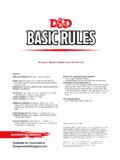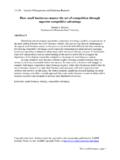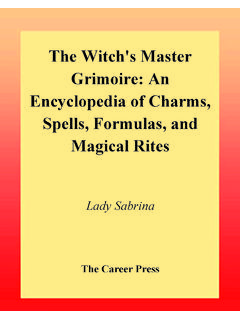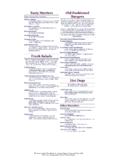Transcription of MASTER CASTER INSTRUCTIONS 10/1/91 …
1 MASTER CASTER INSTRUCTIONS10/1/91 MACHINE deflector baffle to be hung from the existing baffle to help separate the sprues and bullets. swivel handle to be mounted after unpacking. Screw the wood handle into the operating arm until snug then back 1/2 turn and tighten the setscrew. This allows the handle to swivel during pin drivers for changing (4) extra 3/16 X 3/4 stainless steel roll lube sticks for of our Magma flux. Looks like an ice cube. Add a piece the size of a small pea to your alloy. Stir in deeply. Scrape the sides and bottom of the melting pot. When the smoke stops skim the dross and discard. Dross must be disposed to a recycle center, do not send to the of MASTER LUBRICANT, apply this to the mold when it is hot. MASTER LUBRICANT is also an excellent rust preventative for mold t throw away the expanded metal snap on guard or you will end up with a hot sprue in your MASTER CASTER requires a sturdy bench for mounting. The bench should be bolted to the wall or are two mounting options for the MASTER can be safely mounted with the center and rear bolt holes to hang the front section of the machine over the edge of the bench so that the bullets and sprues drop in front of the can be mounted using all six-bolt holes.
2 A hole will be needed below the forward open section of the machine for the bullets and sprues to drop through and be caught the pot into the appropriate 120V or 240V outlet. Be sure the circuit is grounded by means of a three-wire plug, or run a separate ground wire from the machine to a good ground. The circuit you are plugged into should be fused or have a circuit breaker with a 15A capacity. Initially fill the pot with smaller pieces of lead or alloy until molten, then fill half full. It is not necessary to keep the pot full to the top. It is safer to use half full and will cast better. When half-full and cold, the pot should melt down and come to casting temperature in 15 to 30 Fault Interrupter (GFI) circuit breakers can be a problem with the MASTER CASTER pot. Try not to operate the pot on a GFI circuit. The large band heater tends to absorb moisture when cooling; this causes the GFI breaker to become sensitive. For example, if you were to plug the pot into a non-GFI circuit for even a few minutes, then plug into a GFI circuit, the pot would then melt normally.
3 This is not a safety problem it is just the nature of large band a full pot of lead can cause the pour spout to leak; there is no cure for this. With the operating handle down a small size bread-baking pan placed under the pour spout will catch the drip. Once the pot is molten the drip should stop. If the dripping continues there may be foreign deposits on the valve stem and seat, a light tap on the top of the valve stem should stop the (mcaster) MASTER CASTER INSTRUCTIONS10/1/91 OPERATIONDo not operate the machine cold. When the alloy is molten, move the handle to its extreme upward position until it stops, then depress the pour lever and hold until the sprues fill and join together. A large sprue helps the base of the bullets fill and aids in sprue release when cut the handle slowly toward you until the sprue chills enough to shear without pulling holes in the base of the bullets. Then with a rapid motion, pull the handle to its full down position. At this time the sprue and bullets should release from the mold.
4 If a bullet should happen to stick, raise the operating handle about two inches and bring it down with a hard rap. When sprue and bullets are clear of the mold you again move the handle to the upward position and repeat the our shop we find that a fifteen-second interval casts a 38 - 158 grain bullet without overheating the mold. A fifteen-second interval computes to 480 bullets per hour. By experimentation you will find your own ideal casting interval. Larger bullets will require a longer interval and small bullets can be cast more quickly. CHANGING MOLDSWith the pin driver supplied, drive the two roll pins downward through the mold carrier, slide the mold out and slide your new mold back into the grooves of the carrier arms, then with the other pin driver, drive the roll pins back into the top of the carrier changing a mold you may need to make some adjustments. All adjustments are simple. Be sure the guide rails are just tight enough on the mold carriers to keep the mold halves from pinching the bullets when the sprue is being sheared.
5 Be sure the sprue cutter plate is resetting exactly to the center of the mold cavities and the lead pours exactly through the center of the holes in the sprue plate. This may be accomplished by a combination of adjustments, moving the pot from side to side. Changing the stop position on the arm and by adjusting the sprue-closing bracket under the pot and the sprue cutter stop on the front of the lead-pouring rate is also important. Slow pour causes a stacked looking bullet and too fast a pour will cause air to be trapped in the mold causing a pinhole in the base and a rounded base on the bullet. Experiment with the lead level in the melting pot and the amount you open the lead pouring if the lead streams appear in a vortex, (spinning) decrease the pour. Crooked streams of lead indicate oxides building up in the pour spouts (orifice plate). Eventually the orifice plate and the valve stem will need to be removed to clear any oxidation build up. All of these valve parts are made of high quality stainless steel and will not be harmed by long term oxidation.
6 When working on the valve be very careful not to damage any sharp corners with hard tools and your pot will last lube stick supplied with your machine is for lubricating the carrier arms and the guide rails where they contact the carrier arms. No other lubrication is (mcaster) MASTER CASTER INSTRUCTIONS10/1/91 MOLD CAREM olds must be kept in new condition. Never use metal objects on the mold in the machine. With the mold out of the machine, an industrial razor blade is the best tool for cleaning the faces of the molds. Never break any corners on the mold cavities with the razor blade. To clean the faces of the molds hold the razor blade at a steep angle to the mold and shave toward the mold cavities. Never scrape the cavities or their edges with anything harder than mold storage is also important, they rust very easily. A heated cabinet works well for rust prevention. Magma s MASTER Lubricant is an excellent rust ALLOYSA lways use clean metal in the pot, but you must occasionally flux the metal to keep the pot clean.
7 Standard paraffin or beeswax works well for this. Drop in a piece about the size of a .38 caliber bullet and stir vigorously. Use a large perforated spoon for stirring the molten lead : Fluxing can cause a flash fire, this is normal, but gauntlet type gloves should be worn during this operation. Once the ash and residue have risen to the top of the pot and has quit smoking, skim it off and discard properly. VENTINGIt is important in any casting operation that it be performed in a well-ventilated area. In the case of a stationary casting furnace such as the MASTER CASTER , an exhaust hood should be installed directly over the melting pot and have sufficient suction to remove smoke caused in the melting, fluxing and continued lead heating operation of the machine. No air should be flowing over the mold during the pour operation; this will cause unequal cooling of the lead streams and will cause casting problems. Below 800 degrees lead expels no poisonous gases just smoke from whatever contaminates are in the lead.
8 Lead poisoning is caused by improper hygiene after handling lead. Don t eat or smoke before washing your ADJUSTMENTThe melting pot has a large band heater controlled by a thermostat. The thermostat is carefully calibrated in our plant. Field calibration is seldom necessary and should not be resorted to unless the thermostat is not maintaining desired temperature. A thermometer must be used to calibrate the thermostat - overheated lead expels poisonous or decrease the temperature by the following: First, loosen the small setscrew on the thermostat knob, then remove the knob. Using a small screwdriver, insert it in the hollow stem and engage the adjusting screw. Turning the screw to the left or counter-clockwise increases the temperature. Temperature adjustments should be made in small increments. Allow the temperature to rise or lower to the new setting before making further adjustments. MAKE ADJUSTMENTS SLOWLY IN SMALL (mcaster) MASTER CASTER INSTRUCTIONS10/1/914(mcaster) MASTER CASTER INSTRUCTIONS10/1/915(mcaster) MASTER CASTER INSTRUCTIONS10/1/916(mcaster) MASTER CASTER INSTRUCTIONS10/1/917(mcaster) MASTER CASTER INSTRUCTIONS10/1/918(mcaster) MASTER CASTER INSTRUCTIONS10/1/919(mcaster) MASTER CASTER INSTRUCTIONS10/1/9110(mcaster) MASTER CASTER INSTRUCTIONS10/1/9111(mcaster)





